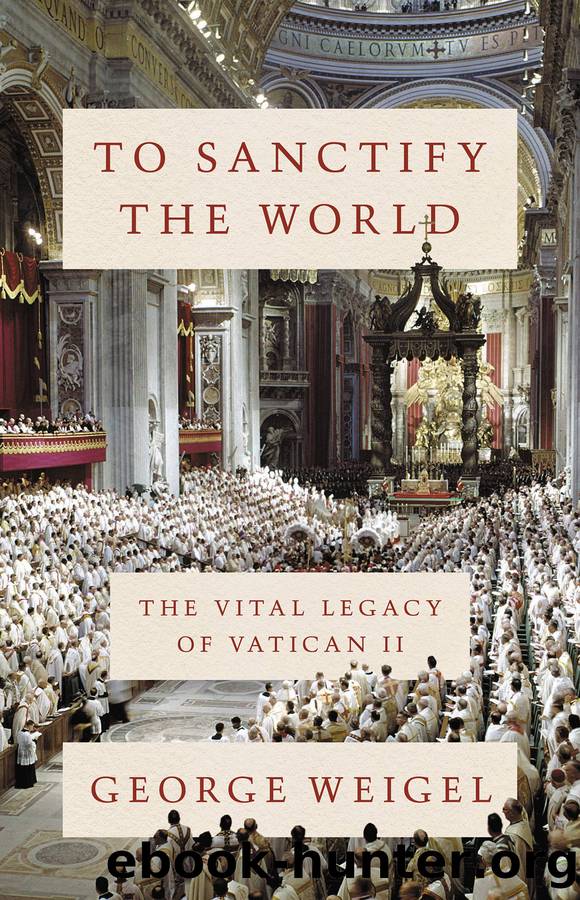To Sanctify the World by George Weigel

Author:George Weigel [WEIGEL, GEORGE]
Language: eng
Format: epub
Publisher: Basic Books
Published: 2022-10-04T00:00:00+00:00
14
Truth, Liberty, and the Limits of State Power
The Declaration on Religious Freedom
IN THE LIGHT OF JOHN XXIIIâS ORIGINAL INTENTION FOR the Second Vatican Council and the intellectual trajectory of Catholic social doctrine between Leo XIIIâs Rerum Novarum (1891) and John Paul IIâs Centesimus Annus (1991), Dignitatis Humanae, the Councilâs Declaration on Religious Freedom, comes into focus as both a major development in the tangled history of Catholicism and political modernity and a further specification of Vatican IIâs design for a revitalized Western humanism.
Taking its Latin incipit from the âhuman dignityâ in which it grounds the right of religious freedom, the declaration boldly called for a modernity in which men and women are free to fulfill their innate desire for communion with the divine. Living out the theotropic nature of the human person and thereby meeting the human obligation to seek and adhere to the truth are essential to genuine human flourishing, the declaration taught. Concurrently, Dignitatis Humanae extended the analysis of the just state sketched in Gaudium et Spes. In doing so, it achieved a true development of Catholic social doctrine while urging the modern state to recognize the limits of its competence and the boundaries of its authority.
Dignitatis Humanae was the primary reason for the only formal fissure in the unity of the Catholic Church following the Second Vatican Council: the schism initiated in 1988 by the French archbishop Marcel Lefebvre and his followers. The Lefebrvists took offense at many of the Councilâs reforms and were especially critical of the implementation of the Constitution on the Sacred Liturgy. At the root of their dissent, however, was Dignitatis Humanaeâs teaching on the inalienable right of religious freedom. This, Lefebvre insisted, was a fatal concession to political modernity and a betrayal of previous Catholic teaching on the right relationship between the Church and states. It was neither. But as similar charges continue to be made in the twenty-first century, a brief review of the struggle between Catholicism and political modernity will help set the stage for understanding what Dignitatis Humanae taught; why that teaching was both orthodox and necessary; and how that teaching poses a greater challenge to political modernity than anything proposed by the followers of Archbishop Lefebvre, by defenders of the ancien régimeâs church-state arrangements, and by twenty-first-century Catholic integralists.1
Download
This site does not store any files on its server. We only index and link to content provided by other sites. Please contact the content providers to delete copyright contents if any and email us, we'll remove relevant links or contents immediately.
Resisting Happiness by Matthew Kelly(3303)
The Social Psychology of Inequality by Unknown(2941)
Day by Elie Wiesel(2721)
Designing Your Life by Bill Burnett(2667)
The Giving Tree by Shel Silverstein(2290)
Human Design by Chetan Parkyn(2032)
Angels of God: The Bible, the Church and the Heavenly Hosts by Mike Aquilina(1932)
The Supreme Gift by Paulo Coelho(1902)
Jesus of Nazareth by Joseph Ratzinger(1769)
Hostage to the Devil by Malachi Martin(1757)
Augustine: Conversions to Confessions by Robin Lane Fox(1737)
7 Secrets of Divine Mercy by Vinny Flynn(1691)
Dark Mysteries of the Vatican by H. Paul Jeffers(1676)
The Vatican Pimpernel by Brian Fleming(1668)
St. Thomas Aquinas by G. K. Chesterton(1606)
Saints & Angels by Doreen Virtue(1579)
The Ratline by Philippe Sands(1515)
My Daily Catholic Bible, NABRE by Thigpen Edited by Dr. Paul(1465)
Called to Life by Jacques Philippe(1456)
